CJS 2010-2015 Government Policy: Crime Prevention
VerifiedAdded on 2023/06/12
|8
|2101
|127
AI Summary
This article discusses the UK government's policies and strategies for preventing crimes in the society. It covers the approaches and legislations implemented for reducing the rate of crimes, including the child sex offender disclosure scheme, hate crimes legislation, and the formation of new programs to stop individuals from being involved in serious crimes. The article also highlights the importance of community safety partnerships and police crime commissioners in ensuring safety and strategic plans for victims, witnesses, and communities affected by serious crimes.
Contribute Materials
Your contribution can guide someone’s learning journey. Share your
documents today.
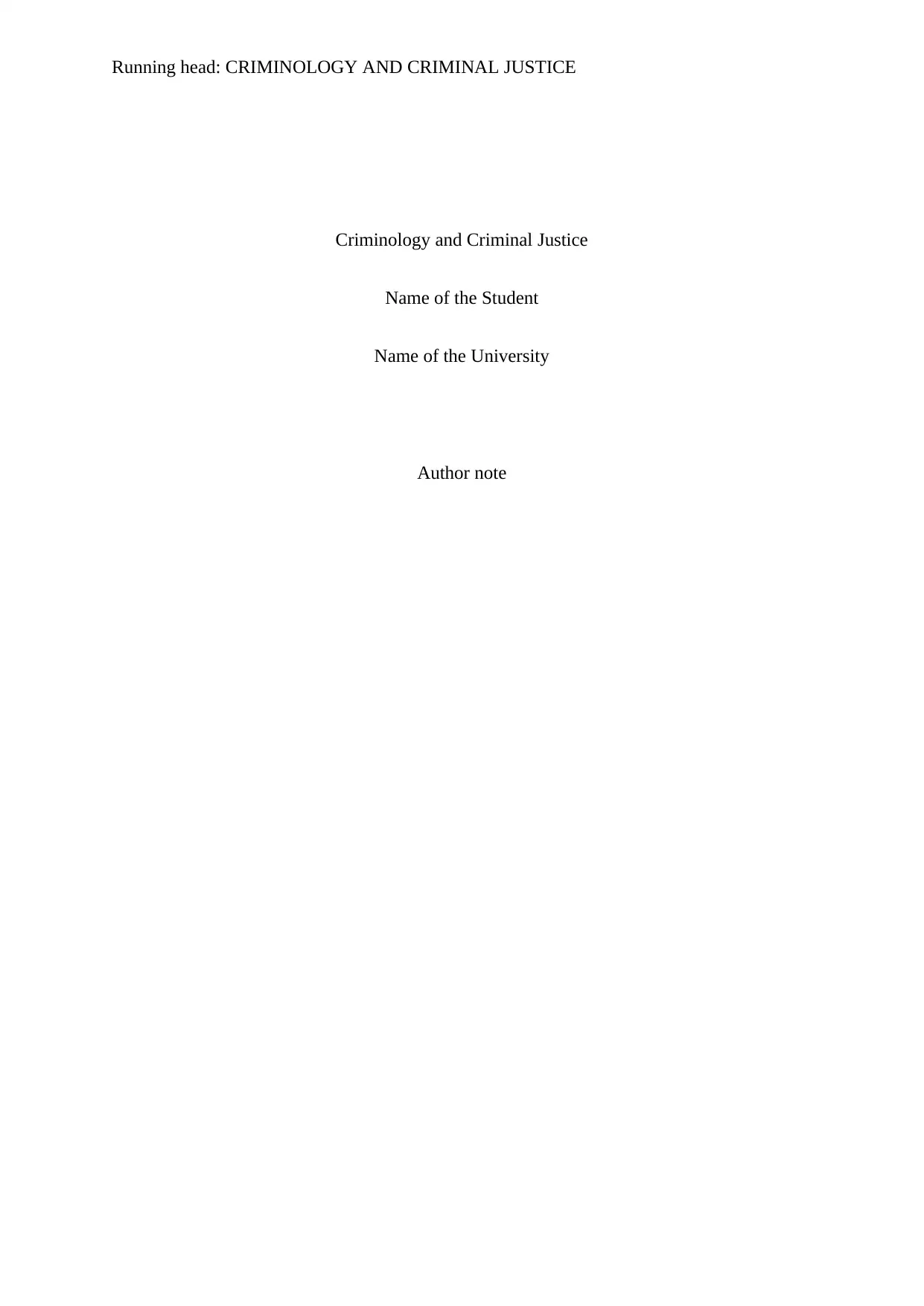
Running head: CRIMINOLOGY AND CRIMINAL JUSTICE
Criminology and Criminal Justice
Name of the Student
Name of the University
Author note
Criminology and Criminal Justice
Name of the Student
Name of the University
Author note
Secure Best Marks with AI Grader
Need help grading? Try our AI Grader for instant feedback on your assignments.
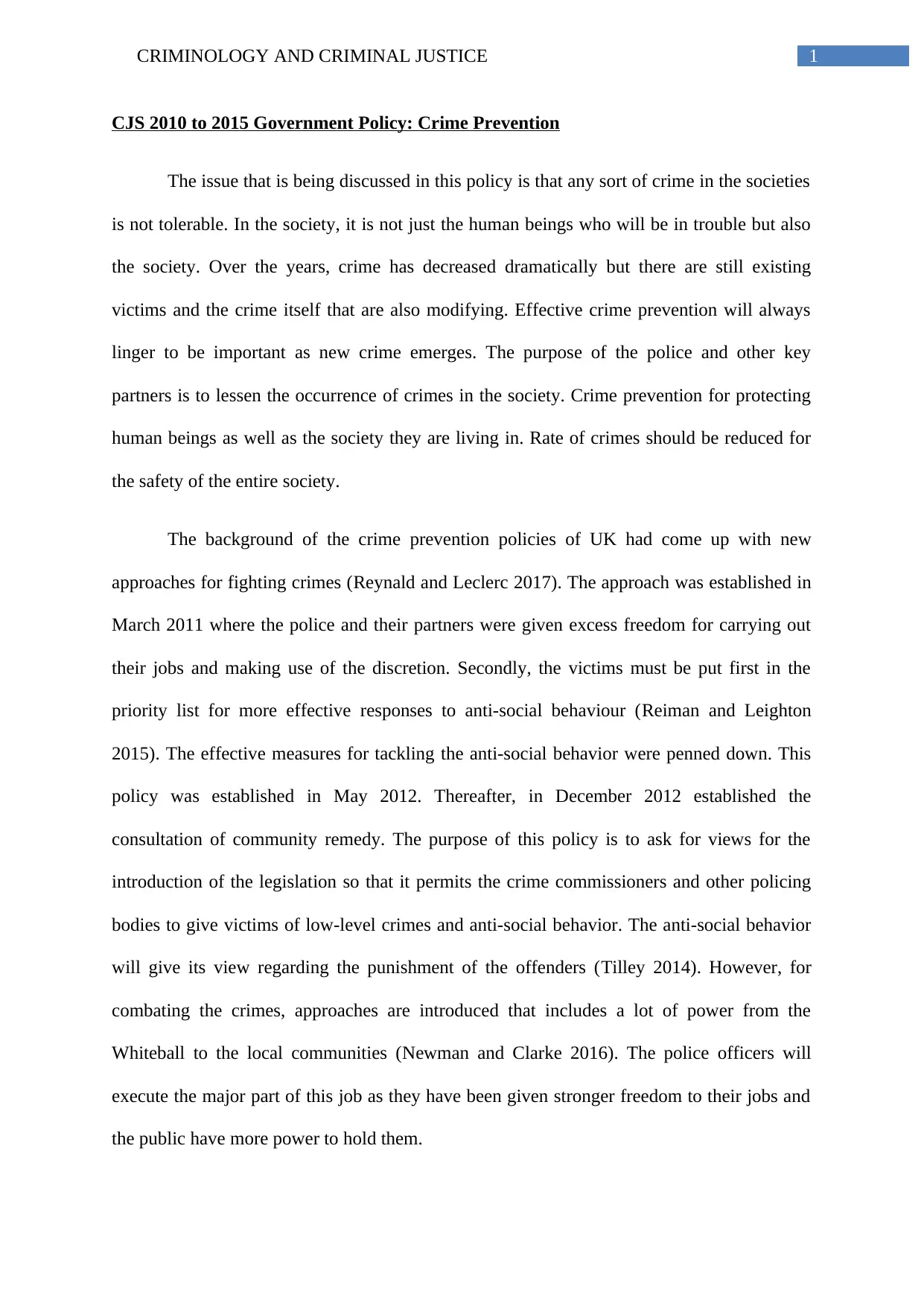
1CRIMINOLOGY AND CRIMINAL JUSTICE
CJS 2010 to 2015 Government Policy: Crime Prevention
The issue that is being discussed in this policy is that any sort of crime in the societies
is not tolerable. In the society, it is not just the human beings who will be in trouble but also
the society. Over the years, crime has decreased dramatically but there are still existing
victims and the crime itself that are also modifying. Effective crime prevention will always
linger to be important as new crime emerges. The purpose of the police and other key
partners is to lessen the occurrence of crimes in the society. Crime prevention for protecting
human beings as well as the society they are living in. Rate of crimes should be reduced for
the safety of the entire society.
The background of the crime prevention policies of UK had come up with new
approaches for fighting crimes (Reynald and Leclerc 2017). The approach was established in
March 2011 where the police and their partners were given excess freedom for carrying out
their jobs and making use of the discretion. Secondly, the victims must be put first in the
priority list for more effective responses to anti-social behaviour (Reiman and Leighton
2015). The effective measures for tackling the anti-social behavior were penned down. This
policy was established in May 2012. Thereafter, in December 2012 established the
consultation of community remedy. The purpose of this policy is to ask for views for the
introduction of the legislation so that it permits the crime commissioners and other policing
bodies to give victims of low-level crimes and anti-social behavior. The anti-social behavior
will give its view regarding the punishment of the offenders (Tilley 2014). However, for
combating the crimes, approaches are introduced that includes a lot of power from the
Whiteball to the local communities (Newman and Clarke 2016). The police officers will
execute the major part of this job as they have been given stronger freedom to their jobs and
the public have more power to hold them.
CJS 2010 to 2015 Government Policy: Crime Prevention
The issue that is being discussed in this policy is that any sort of crime in the societies
is not tolerable. In the society, it is not just the human beings who will be in trouble but also
the society. Over the years, crime has decreased dramatically but there are still existing
victims and the crime itself that are also modifying. Effective crime prevention will always
linger to be important as new crime emerges. The purpose of the police and other key
partners is to lessen the occurrence of crimes in the society. Crime prevention for protecting
human beings as well as the society they are living in. Rate of crimes should be reduced for
the safety of the entire society.
The background of the crime prevention policies of UK had come up with new
approaches for fighting crimes (Reynald and Leclerc 2017). The approach was established in
March 2011 where the police and their partners were given excess freedom for carrying out
their jobs and making use of the discretion. Secondly, the victims must be put first in the
priority list for more effective responses to anti-social behaviour (Reiman and Leighton
2015). The effective measures for tackling the anti-social behavior were penned down. This
policy was established in May 2012. Thereafter, in December 2012 established the
consultation of community remedy. The purpose of this policy is to ask for views for the
introduction of the legislation so that it permits the crime commissioners and other policing
bodies to give victims of low-level crimes and anti-social behavior. The anti-social behavior
will give its view regarding the punishment of the offenders (Tilley 2014). However, for
combating the crimes, approaches are introduced that includes a lot of power from the
Whiteball to the local communities (Newman and Clarke 2016). The police officers will
execute the major part of this job as they have been given stronger freedom to their jobs and
the public have more power to hold them.

2CRIMINOLOGY AND CRIMINAL JUSTICE
For decreasing the level of crimes, community triggers were created for managing and
handling the behavior of the anti-social. Community safety partnerships are used by the crime
and police commissioners for working out with the social approaches while dealing with the
issues. The issues consist of drug, alcohol misuse and re-offending. Thereafter, national
referral mechanism have been established for making the situation easier for the benefit of all
the various agencies (Weisburd, Farrington and Gill 2017). These agencies include cases of
trafficking and corporate cases. Getting access to advice and allocating information regarding
the potential victims for accommodation and support. It produced new crime strategies for
organizing and reducing the rate of crimes. The strategies make it easier for the
commissioners to chalk out the plans for reducing the level of crimes. Street-level crime
maps can form to give the public updated information regarding the activities and occurrence
of the incidents on the streets (Wortley and Townsley 2016). This is done as it can confront
the performance of the police.
Crimes that occur in the societies are of various kinds. Therefore, there are crimes
relating to children and young people. These crimes can be prevented as well and should be
similarly as the other crimes. Firstly, schemes should be formed and implemented that will
permit anyone with reference to a child (Crawford and Evans 2017). The purpose or aim of
this is to find out if someone related to their lives have a documentation or record of the child
sexual offences (Tilley 2014). Hate crimes should be legislated for preventing the rate of
crimes. Hating the crimes will make the society aware of the nature of crimes occurring.
Crimes can be linked to children, adults and other human beings who are related to the
society and are living in it. For stopping cash payments legislations must be created
(Newman and Clarke 2016). This is because that cash is used to purchase scrap metal and
reforming the regulation of the scrap metal industry for preventing unprincipled or immoral
dealers purchasing stolen metal. Thus, if these policies and legislations are carried out and
For decreasing the level of crimes, community triggers were created for managing and
handling the behavior of the anti-social. Community safety partnerships are used by the crime
and police commissioners for working out with the social approaches while dealing with the
issues. The issues consist of drug, alcohol misuse and re-offending. Thereafter, national
referral mechanism have been established for making the situation easier for the benefit of all
the various agencies (Weisburd, Farrington and Gill 2017). These agencies include cases of
trafficking and corporate cases. Getting access to advice and allocating information regarding
the potential victims for accommodation and support. It produced new crime strategies for
organizing and reducing the rate of crimes. The strategies make it easier for the
commissioners to chalk out the plans for reducing the level of crimes. Street-level crime
maps can form to give the public updated information regarding the activities and occurrence
of the incidents on the streets (Wortley and Townsley 2016). This is done as it can confront
the performance of the police.
Crimes that occur in the societies are of various kinds. Therefore, there are crimes
relating to children and young people. These crimes can be prevented as well and should be
similarly as the other crimes. Firstly, schemes should be formed and implemented that will
permit anyone with reference to a child (Crawford and Evans 2017). The purpose or aim of
this is to find out if someone related to their lives have a documentation or record of the child
sexual offences (Tilley 2014). Hate crimes should be legislated for preventing the rate of
crimes. Hating the crimes will make the society aware of the nature of crimes occurring.
Crimes can be linked to children, adults and other human beings who are related to the
society and are living in it. For stopping cash payments legislations must be created
(Newman and Clarke 2016). This is because that cash is used to purchase scrap metal and
reforming the regulation of the scrap metal industry for preventing unprincipled or immoral
dealers purchasing stolen metal. Thus, if these policies and legislations are carried out and
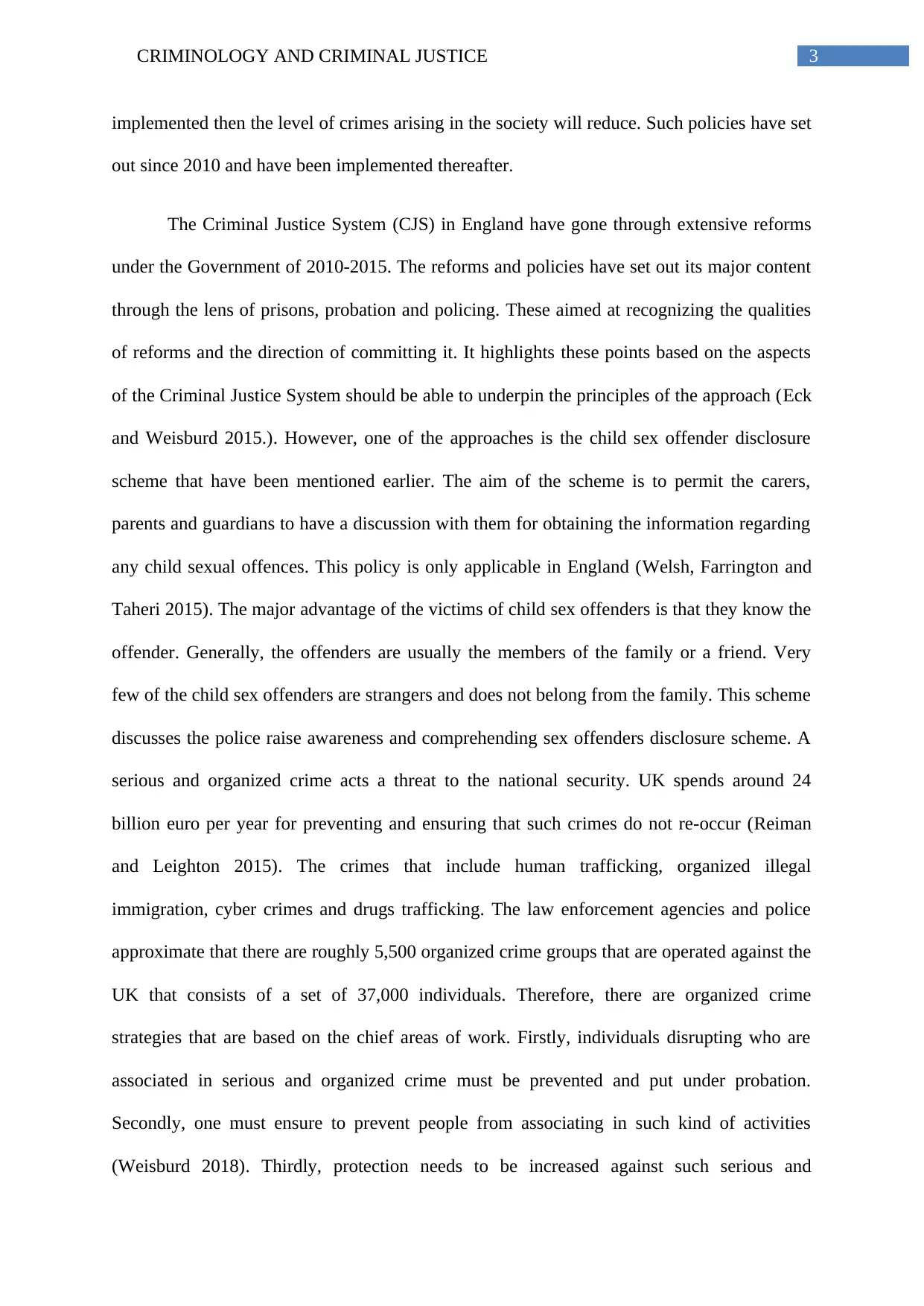
3CRIMINOLOGY AND CRIMINAL JUSTICE
implemented then the level of crimes arising in the society will reduce. Such policies have set
out since 2010 and have been implemented thereafter.
The Criminal Justice System (CJS) in England have gone through extensive reforms
under the Government of 2010-2015. The reforms and policies have set out its major content
through the lens of prisons, probation and policing. These aimed at recognizing the qualities
of reforms and the direction of committing it. It highlights these points based on the aspects
of the Criminal Justice System should be able to underpin the principles of the approach (Eck
and Weisburd 2015.). However, one of the approaches is the child sex offender disclosure
scheme that have been mentioned earlier. The aim of the scheme is to permit the carers,
parents and guardians to have a discussion with them for obtaining the information regarding
any child sexual offences. This policy is only applicable in England (Welsh, Farrington and
Taheri 2015). The major advantage of the victims of child sex offenders is that they know the
offender. Generally, the offenders are usually the members of the family or a friend. Very
few of the child sex offenders are strangers and does not belong from the family. This scheme
discusses the police raise awareness and comprehending sex offenders disclosure scheme. A
serious and organized crime acts a threat to the national security. UK spends around 24
billion euro per year for preventing and ensuring that such crimes do not re-occur (Reiman
and Leighton 2015). The crimes that include human trafficking, organized illegal
immigration, cyber crimes and drugs trafficking. The law enforcement agencies and police
approximate that there are roughly 5,500 organized crime groups that are operated against the
UK that consists of a set of 37,000 individuals. Therefore, there are organized crime
strategies that are based on the chief areas of work. Firstly, individuals disrupting who are
associated in serious and organized crime must be prevented and put under probation.
Secondly, one must ensure to prevent people from associating in such kind of activities
(Weisburd 2018). Thirdly, protection needs to be increased against such serious and
implemented then the level of crimes arising in the society will reduce. Such policies have set
out since 2010 and have been implemented thereafter.
The Criminal Justice System (CJS) in England have gone through extensive reforms
under the Government of 2010-2015. The reforms and policies have set out its major content
through the lens of prisons, probation and policing. These aimed at recognizing the qualities
of reforms and the direction of committing it. It highlights these points based on the aspects
of the Criminal Justice System should be able to underpin the principles of the approach (Eck
and Weisburd 2015.). However, one of the approaches is the child sex offender disclosure
scheme that have been mentioned earlier. The aim of the scheme is to permit the carers,
parents and guardians to have a discussion with them for obtaining the information regarding
any child sexual offences. This policy is only applicable in England (Welsh, Farrington and
Taheri 2015). The major advantage of the victims of child sex offenders is that they know the
offender. Generally, the offenders are usually the members of the family or a friend. Very
few of the child sex offenders are strangers and does not belong from the family. This scheme
discusses the police raise awareness and comprehending sex offenders disclosure scheme. A
serious and organized crime acts a threat to the national security. UK spends around 24
billion euro per year for preventing and ensuring that such crimes do not re-occur (Reiman
and Leighton 2015). The crimes that include human trafficking, organized illegal
immigration, cyber crimes and drugs trafficking. The law enforcement agencies and police
approximate that there are roughly 5,500 organized crime groups that are operated against the
UK that consists of a set of 37,000 individuals. Therefore, there are organized crime
strategies that are based on the chief areas of work. Firstly, individuals disrupting who are
associated in serious and organized crime must be prevented and put under probation.
Secondly, one must ensure to prevent people from associating in such kind of activities
(Weisburd 2018). Thirdly, protection needs to be increased against such serious and
Secure Best Marks with AI Grader
Need help grading? Try our AI Grader for instant feedback on your assignments.
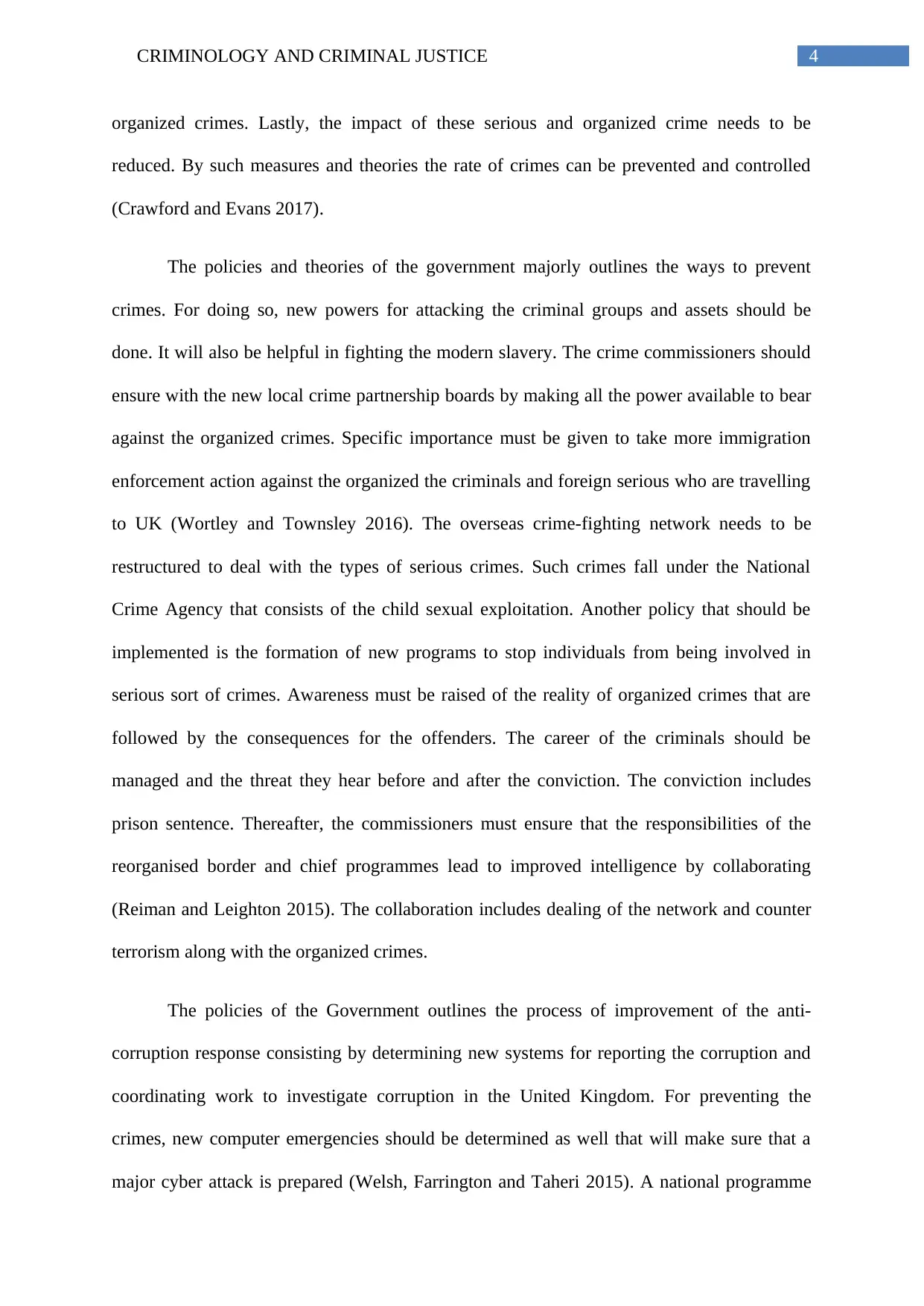
4CRIMINOLOGY AND CRIMINAL JUSTICE
organized crimes. Lastly, the impact of these serious and organized crime needs to be
reduced. By such measures and theories the rate of crimes can be prevented and controlled
(Crawford and Evans 2017).
The policies and theories of the government majorly outlines the ways to prevent
crimes. For doing so, new powers for attacking the criminal groups and assets should be
done. It will also be helpful in fighting the modern slavery. The crime commissioners should
ensure with the new local crime partnership boards by making all the power available to bear
against the organized crimes. Specific importance must be given to take more immigration
enforcement action against the organized the criminals and foreign serious who are travelling
to UK (Wortley and Townsley 2016). The overseas crime-fighting network needs to be
restructured to deal with the types of serious crimes. Such crimes fall under the National
Crime Agency that consists of the child sexual exploitation. Another policy that should be
implemented is the formation of new programs to stop individuals from being involved in
serious sort of crimes. Awareness must be raised of the reality of organized crimes that are
followed by the consequences for the offenders. The career of the criminals should be
managed and the threat they hear before and after the conviction. The conviction includes
prison sentence. Thereafter, the commissioners must ensure that the responsibilities of the
reorganised border and chief programmes lead to improved intelligence by collaborating
(Reiman and Leighton 2015). The collaboration includes dealing of the network and counter
terrorism along with the organized crimes.
The policies of the Government outlines the process of improvement of the anti-
corruption response consisting by determining new systems for reporting the corruption and
coordinating work to investigate corruption in the United Kingdom. For preventing the
crimes, new computer emergencies should be determined as well that will make sure that a
major cyber attack is prepared (Welsh, Farrington and Taheri 2015). A national programme
organized crimes. Lastly, the impact of these serious and organized crime needs to be
reduced. By such measures and theories the rate of crimes can be prevented and controlled
(Crawford and Evans 2017).
The policies and theories of the government majorly outlines the ways to prevent
crimes. For doing so, new powers for attacking the criminal groups and assets should be
done. It will also be helpful in fighting the modern slavery. The crime commissioners should
ensure with the new local crime partnership boards by making all the power available to bear
against the organized crimes. Specific importance must be given to take more immigration
enforcement action against the organized the criminals and foreign serious who are travelling
to UK (Wortley and Townsley 2016). The overseas crime-fighting network needs to be
restructured to deal with the types of serious crimes. Such crimes fall under the National
Crime Agency that consists of the child sexual exploitation. Another policy that should be
implemented is the formation of new programs to stop individuals from being involved in
serious sort of crimes. Awareness must be raised of the reality of organized crimes that are
followed by the consequences for the offenders. The career of the criminals should be
managed and the threat they hear before and after the conviction. The conviction includes
prison sentence. Thereafter, the commissioners must ensure that the responsibilities of the
reorganised border and chief programmes lead to improved intelligence by collaborating
(Reiman and Leighton 2015). The collaboration includes dealing of the network and counter
terrorism along with the organized crimes.
The policies of the Government outlines the process of improvement of the anti-
corruption response consisting by determining new systems for reporting the corruption and
coordinating work to investigate corruption in the United Kingdom. For preventing the
crimes, new computer emergencies should be determined as well that will make sure that a
major cyber attack is prepared (Welsh, Farrington and Taheri 2015). A national programme
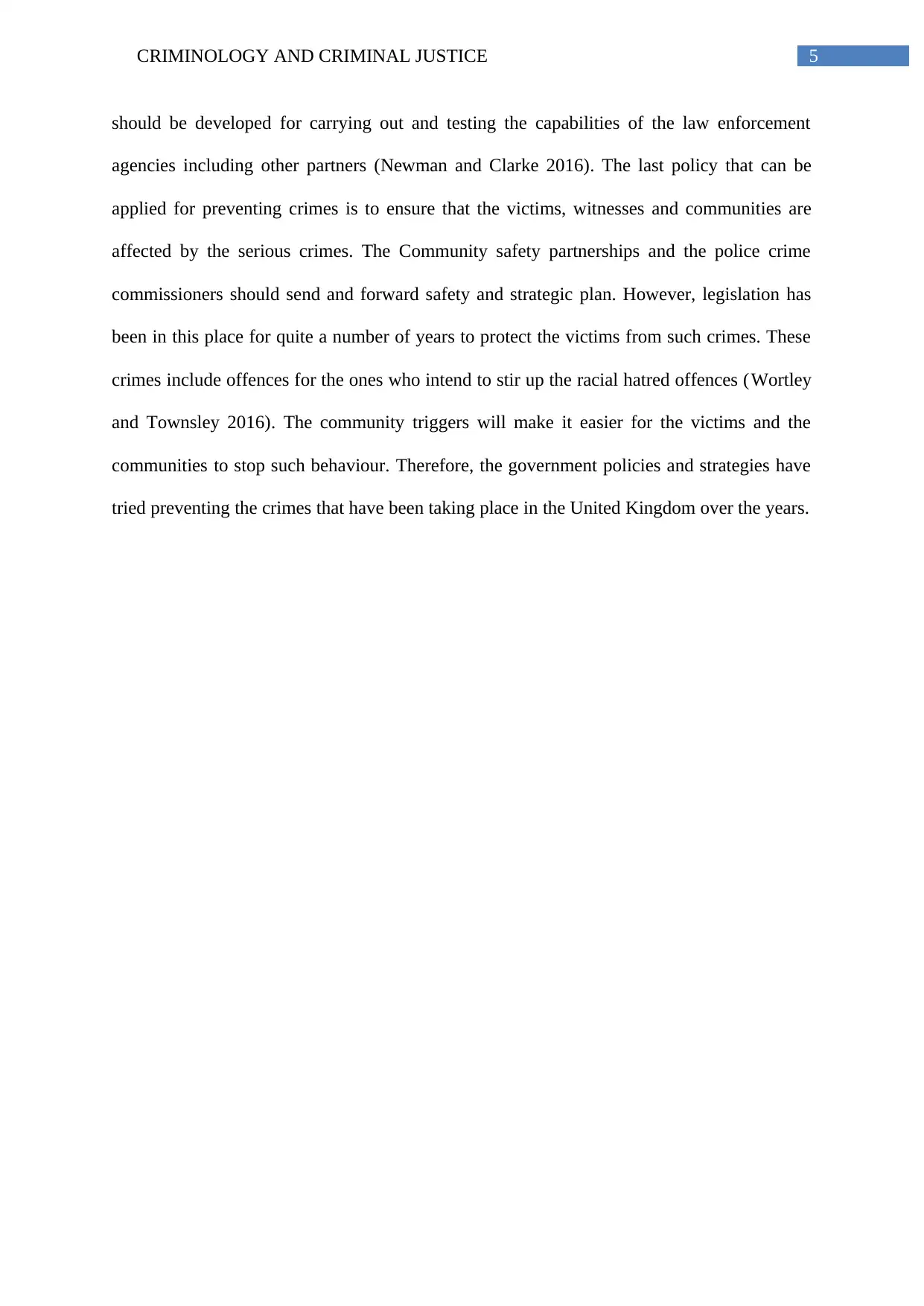
5CRIMINOLOGY AND CRIMINAL JUSTICE
should be developed for carrying out and testing the capabilities of the law enforcement
agencies including other partners (Newman and Clarke 2016). The last policy that can be
applied for preventing crimes is to ensure that the victims, witnesses and communities are
affected by the serious crimes. The Community safety partnerships and the police crime
commissioners should send and forward safety and strategic plan. However, legislation has
been in this place for quite a number of years to protect the victims from such crimes. These
crimes include offences for the ones who intend to stir up the racial hatred offences (Wortley
and Townsley 2016). The community triggers will make it easier for the victims and the
communities to stop such behaviour. Therefore, the government policies and strategies have
tried preventing the crimes that have been taking place in the United Kingdom over the years.
should be developed for carrying out and testing the capabilities of the law enforcement
agencies including other partners (Newman and Clarke 2016). The last policy that can be
applied for preventing crimes is to ensure that the victims, witnesses and communities are
affected by the serious crimes. The Community safety partnerships and the police crime
commissioners should send and forward safety and strategic plan. However, legislation has
been in this place for quite a number of years to protect the victims from such crimes. These
crimes include offences for the ones who intend to stir up the racial hatred offences (Wortley
and Townsley 2016). The community triggers will make it easier for the victims and the
communities to stop such behaviour. Therefore, the government policies and strategies have
tried preventing the crimes that have been taking place in the United Kingdom over the years.
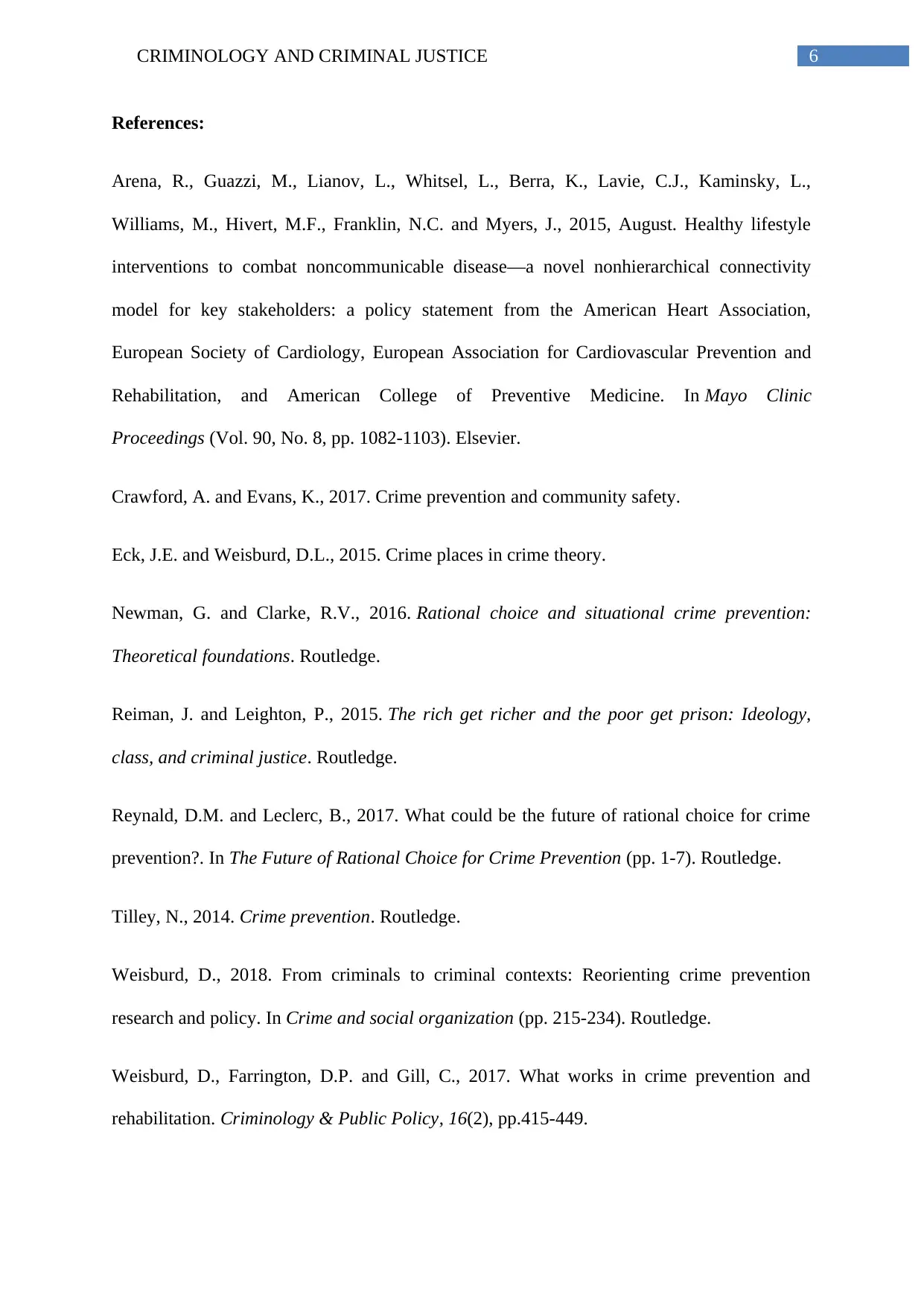
6CRIMINOLOGY AND CRIMINAL JUSTICE
References:
Arena, R., Guazzi, M., Lianov, L., Whitsel, L., Berra, K., Lavie, C.J., Kaminsky, L.,
Williams, M., Hivert, M.F., Franklin, N.C. and Myers, J., 2015, August. Healthy lifestyle
interventions to combat noncommunicable disease—a novel nonhierarchical connectivity
model for key stakeholders: a policy statement from the American Heart Association,
European Society of Cardiology, European Association for Cardiovascular Prevention and
Rehabilitation, and American College of Preventive Medicine. In Mayo Clinic
Proceedings (Vol. 90, No. 8, pp. 1082-1103). Elsevier.
Crawford, A. and Evans, K., 2017. Crime prevention and community safety.
Eck, J.E. and Weisburd, D.L., 2015. Crime places in crime theory.
Newman, G. and Clarke, R.V., 2016. Rational choice and situational crime prevention:
Theoretical foundations. Routledge.
Reiman, J. and Leighton, P., 2015. The rich get richer and the poor get prison: Ideology,
class, and criminal justice. Routledge.
Reynald, D.M. and Leclerc, B., 2017. What could be the future of rational choice for crime
prevention?. In The Future of Rational Choice for Crime Prevention (pp. 1-7). Routledge.
Tilley, N., 2014. Crime prevention. Routledge.
Weisburd, D., 2018. From criminals to criminal contexts: Reorienting crime prevention
research and policy. In Crime and social organization (pp. 215-234). Routledge.
Weisburd, D., Farrington, D.P. and Gill, C., 2017. What works in crime prevention and
rehabilitation. Criminology & Public Policy, 16(2), pp.415-449.
References:
Arena, R., Guazzi, M., Lianov, L., Whitsel, L., Berra, K., Lavie, C.J., Kaminsky, L.,
Williams, M., Hivert, M.F., Franklin, N.C. and Myers, J., 2015, August. Healthy lifestyle
interventions to combat noncommunicable disease—a novel nonhierarchical connectivity
model for key stakeholders: a policy statement from the American Heart Association,
European Society of Cardiology, European Association for Cardiovascular Prevention and
Rehabilitation, and American College of Preventive Medicine. In Mayo Clinic
Proceedings (Vol. 90, No. 8, pp. 1082-1103). Elsevier.
Crawford, A. and Evans, K., 2017. Crime prevention and community safety.
Eck, J.E. and Weisburd, D.L., 2015. Crime places in crime theory.
Newman, G. and Clarke, R.V., 2016. Rational choice and situational crime prevention:
Theoretical foundations. Routledge.
Reiman, J. and Leighton, P., 2015. The rich get richer and the poor get prison: Ideology,
class, and criminal justice. Routledge.
Reynald, D.M. and Leclerc, B., 2017. What could be the future of rational choice for crime
prevention?. In The Future of Rational Choice for Crime Prevention (pp. 1-7). Routledge.
Tilley, N., 2014. Crime prevention. Routledge.
Weisburd, D., 2018. From criminals to criminal contexts: Reorienting crime prevention
research and policy. In Crime and social organization (pp. 215-234). Routledge.
Weisburd, D., Farrington, D.P. and Gill, C., 2017. What works in crime prevention and
rehabilitation. Criminology & Public Policy, 16(2), pp.415-449.
Paraphrase This Document
Need a fresh take? Get an instant paraphrase of this document with our AI Paraphraser
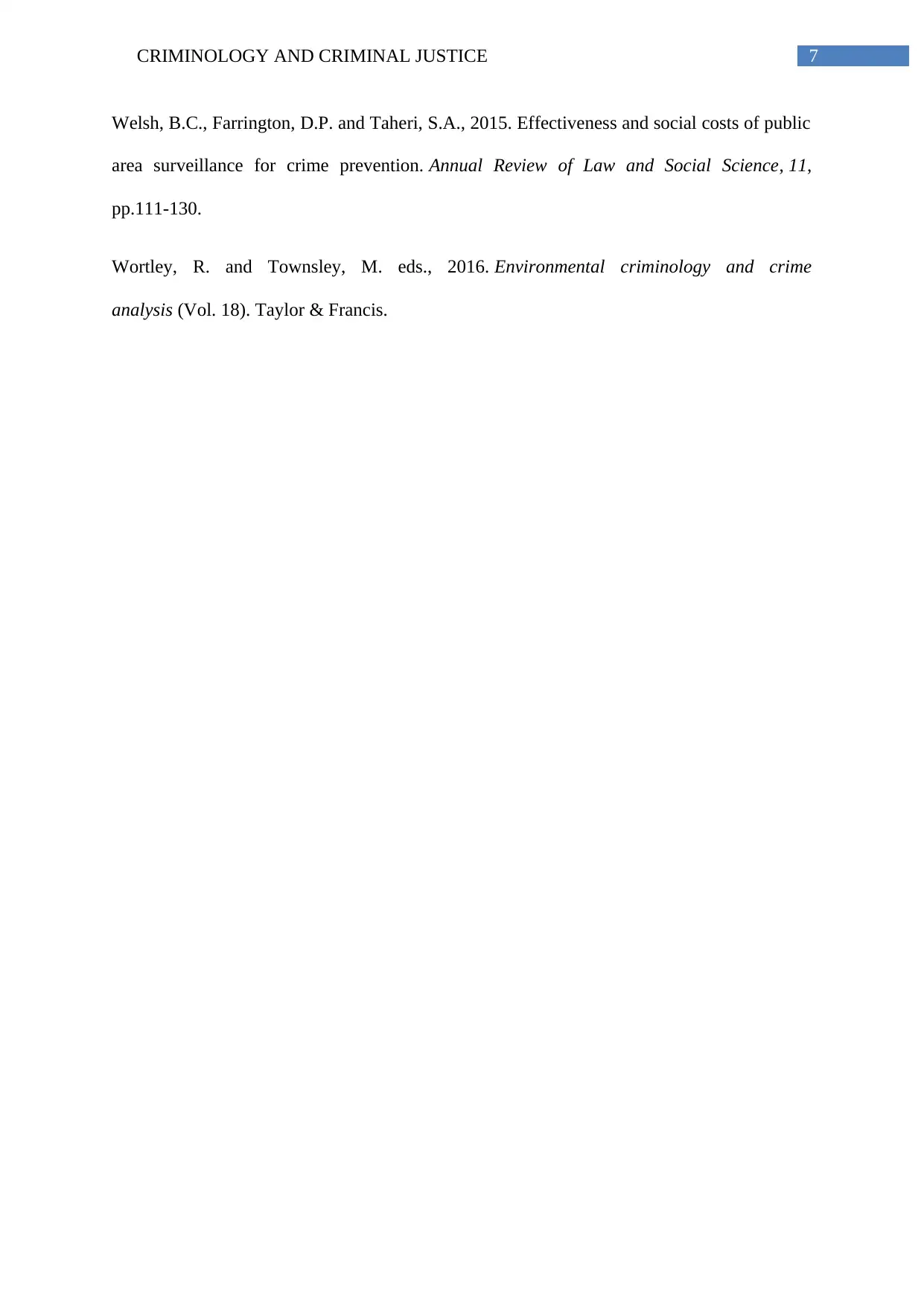
7CRIMINOLOGY AND CRIMINAL JUSTICE
Welsh, B.C., Farrington, D.P. and Taheri, S.A., 2015. Effectiveness and social costs of public
area surveillance for crime prevention. Annual Review of Law and Social Science, 11,
pp.111-130.
Wortley, R. and Townsley, M. eds., 2016. Environmental criminology and crime
analysis (Vol. 18). Taylor & Francis.
Welsh, B.C., Farrington, D.P. and Taheri, S.A., 2015. Effectiveness and social costs of public
area surveillance for crime prevention. Annual Review of Law and Social Science, 11,
pp.111-130.
Wortley, R. and Townsley, M. eds., 2016. Environmental criminology and crime
analysis (Vol. 18). Taylor & Francis.
1 out of 8
Related Documents
Your All-in-One AI-Powered Toolkit for Academic Success.
+13062052269
info@desklib.com
Available 24*7 on WhatsApp / Email
![[object Object]](/_next/static/media/star-bottom.7253800d.svg)
Unlock your academic potential
© 2024 | Zucol Services PVT LTD | All rights reserved.





